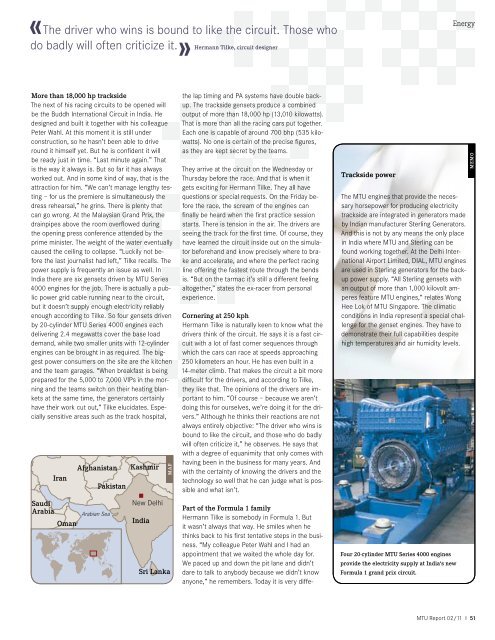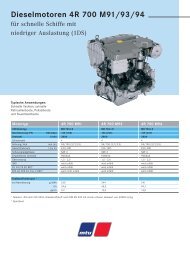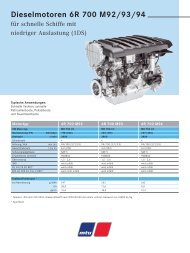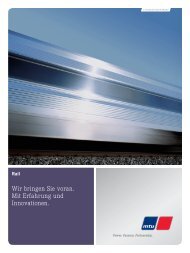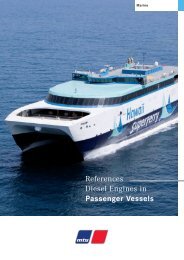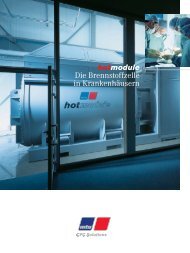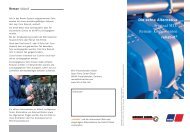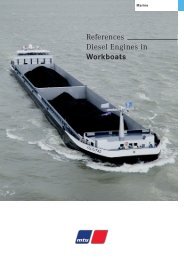Create successful ePaper yourself
Turn your PDF publications into a flip-book with our unique Google optimized e-Paper software.
«The driver who wins is bound to like the circuit. Those who<br />
do badly will <strong>of</strong>ten criticize it.»<br />
Hermann Tilke, circuit designer<br />
More than 18,000 hp trackside<br />
The next <strong>of</strong> his racing circuits to be opened will<br />
be the Buddh International Circuit in India. He<br />
designed and built it together with his colleague<br />
Peter Wahl. At this moment it is still under<br />
construction, so he hasn’t been able to drive<br />
round it himself yet. But he is confident it will<br />
be ready just in time. “Last minute again.” That<br />
is the way it always is. But so far it has always<br />
worked out. And in some kind <strong>of</strong> way, that is the<br />
attraction for him. “We can’t manage lengthy testing<br />
– for us the premiere is simultaneously the<br />
dress rehearsal,” he grins. There is plenty that<br />
can go wrong. At the Malaysian Grand Prix, the<br />
drainpipes above the room overflowed during<br />
the opening press conference attended by the<br />
prime minister. The weight <strong>of</strong> the water eventually<br />
caused the ceiling to collapse. “Luckily not before<br />
the last journalist had left,” Tilke recalls. The<br />
power supply is frequently an issue as well. In<br />
India there are six gensets driven by <strong>MTU</strong> Series<br />
4000 engines for the job. There is actually a public<br />
power grid cable running near to the circuit,<br />
but it doesn’t supply enough electricity reliably<br />
enough according to Tilke. So four gensets driven<br />
by 20-cylinder <strong>MTU</strong> Series 4000 engines each<br />
delivering 2.4 megawatts cover the base load<br />
demand, while two smaller units with 12-cylinder<br />
engines can be brought in as required. The biggest<br />
power consumers on the site are the kitchen<br />
and the team garages. “When breakfast is being<br />
prepared for the 5,000 to 7,000 VIPs in the morning<br />
and the teams switch on their heating blankets<br />
at the same time, the generators certainly<br />
have their work cut out,” Tilke elucidates. Especially<br />
sensitive areas such as the track hospital,<br />
Iran<br />
Oman<br />
Afghanistan<br />
Saudi<br />
Arabia Arabian Sea<br />
Pakistan<br />
Kashmir<br />
New Delhi<br />
India<br />
MAP<br />
<strong>MTU</strong> Brown <strong>MTU</strong> Brown<br />
0-17-28-62 80% der Farbe 60% 40% 20%<br />
CMYK CMYK CMYK CMYK CMYK<br />
<strong>MTU</strong> Blue <strong>MTU</strong> Blue<br />
60% 40% 20%<br />
50-25-0-10 80% der Farbe<br />
CMYK CMYK CMYK<br />
CMYK CMYK<br />
Sri Lanka<br />
the lap timing and PA systems have double backup.<br />
The trackside gensets produce a combined<br />
output <strong>of</strong> more than 18,000 hp (13,010 kilowatts).<br />
That is more than all the racing cars put together.<br />
Each one is capable <strong>of</strong> around 700 bhp (535 kilowatts).<br />
No one is certain <strong>of</strong> the precise figures,<br />
as they are kept secret by the teams.<br />
They arrive at the circuit on the Wednesday or<br />
Thursday before the race. And that is when it<br />
gets exciting for Hermann Tilke. They all have<br />
questions or special requests. On the Friday before<br />
the race, the scream <strong>of</strong> the engines can<br />
finally be heard when the first practice session<br />
starts. There is tension in the air. The drivers are<br />
seeing the track for the first time. Of course, they<br />
have learned the circuit inside out on the simulator<br />
beforehand and know precisely where to brake<br />
and accelerate, and where the perfect racing<br />
line <strong>of</strong>f ering the fastest route through the bends<br />
is. “But on the tarmac it’s still a different feeling<br />
altogether,” states the ex-racer from personal<br />
experience.<br />
Cornering at 250 kph<br />
Hermann Tilke is naturally keen to know what the<br />
drivers think <strong>of</strong> the circuit. He says it is a fast circuit<br />
with a lot <strong>of</strong> fast corner sequences through<br />
which the cars can race at speeds approaching<br />
250 kilometers an hour. He has even built in a<br />
14-meter climb. That makes the circuit a bit more<br />
difficult for the drivers, and according to Tilke,<br />
they like that. The opinions <strong>of</strong> the drivers are important<br />
to him. “Of course – because we aren’t<br />
doing this for ourselves, we’re doing it for the drivers.”<br />
Although he thinks their reactions are not<br />
always entirely objective: “The driver who wins is<br />
bound to like the circuit, and those who do badly<br />
will <strong>of</strong>ten criticize it,” he observes. He says that<br />
with a degree <strong>of</strong> equanimity that only comes with<br />
having been in the business for many years. And<br />
with the certainty <strong>of</strong> knowing the drivers and the<br />
technology so well that he can judge what is possible<br />
and what isn’t.<br />
Part <strong>of</strong> the Formula 1 family<br />
Hermann Tilke is somebody in Formula 1. But<br />
it wasn’t always that way. He smiles when he<br />
thinks back to his first tentative steps in the business.<br />
“My colleague Peter Wahl and I had an<br />
appointment that we waited the whole day for.<br />
We paced up and down the pit lane and didn’t<br />
dare to talk to anybody because we didn’t know<br />
anyone,” he remembers. Today it is very diffe-<br />
Trackside power<br />
Energy<br />
The <strong>MTU</strong> engines that provide the necessary<br />
horsepower for producing electricity<br />
trackside are integrated in generators made<br />
by Indian manufacturer Sterling Generators.<br />
And this is not by any means the only place<br />
in India where <strong>MTU</strong> and Sterling can be<br />
found working together. At the Delhi International<br />
Airport Limited, DIAL, <strong>MTU</strong> engines<br />
are used in Sterling generators for the backup<br />
power supply. “All Sterling gensets with<br />
an output <strong>of</strong> more than 1,000 kilovolt amperes<br />
feature <strong>MTU</strong> engines,“ relates Wong<br />
Hee Lok <strong>of</strong> <strong>MTU</strong> Singapore. The climatic<br />
conditions in India represent a special challenge<br />
for the genset engines. They have to<br />
demonstrate their full capabilities despite<br />
high temperatures and air humidity levels.<br />
Four 20-cylinder <strong>MTU</strong> Series 4000 engines<br />
pro vide the electricity supply at India‘s new<br />
Formula 1 grand prix circuit.<br />
MEMO<br />
<strong>MTU</strong> Report 02/11 I 51


